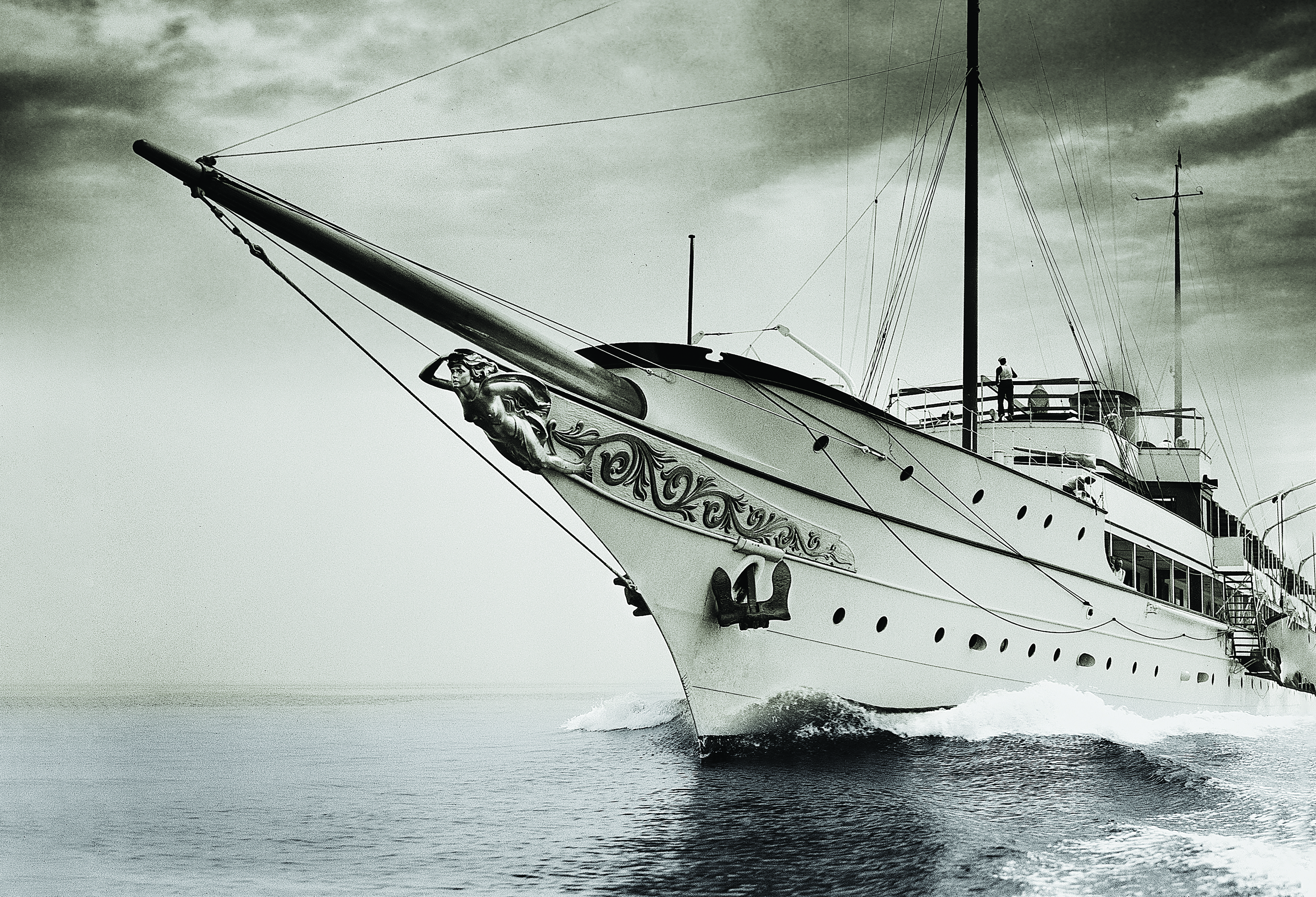Adorned with teak and a gilded bowsprit, SS Hi-Esmaro was rechristened USS Niagara and went to fight the Japanese
Ravaged by aerial attack, the auxiliary tender, heavily burdened with a load of ammunition, depth charges, and aviation fuel, was wallowing in open water between the Solomon Islands and New Guinea on Friday, May 22, 1943. The vessel’s 136-man crew had abandoned ship. A tin fish deliberately loosed by a friendly boat set off explosions that blew the tender to pieces. The pieces sank in the South Pacific. The ship that vanished and its mercy killer both belonged to the U.S. Navy. However, while the attacking craft, though wooden-hulled, was strictly military—a Patrol Torpedo (PT) boat—the vessel destroyed was made of steel and had had a complicated career. Originally an industrialist’s yacht more accustomed to hosting big shots than serving swabbies, USS Niagara had been commissioned for the duration. Now its war was over.
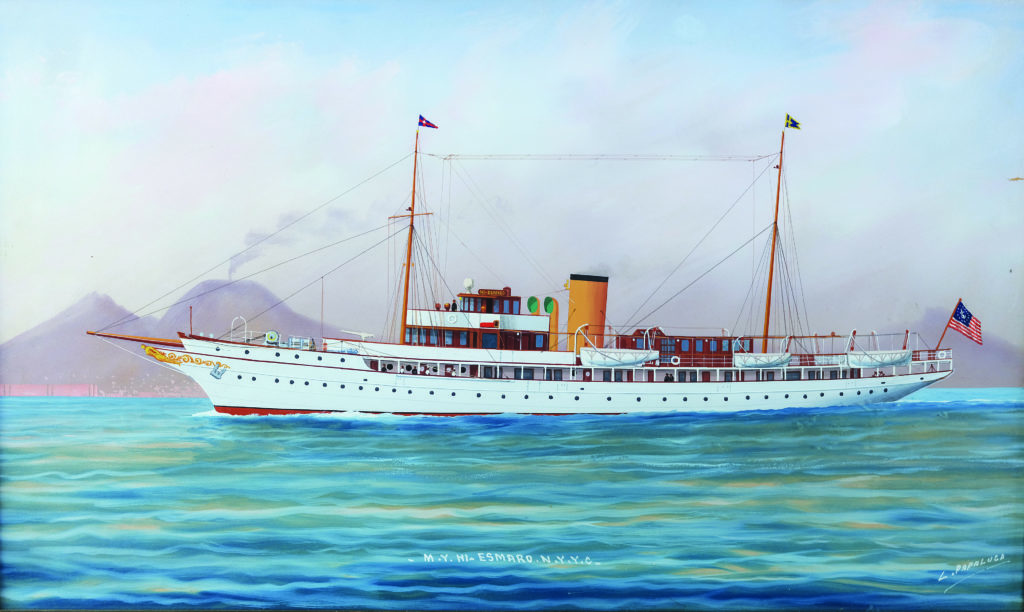
Work on the pleasure craft destined for combat began in July 1928, when American asbestos magnate Hiram Manville, proprietor of the Johns-Manville Company, put a down payment on a diesel yacht at Bath Iron Works in Bath, Maine. By June 1929, when, with most of Bath’s population watching, the 267’, 1,333-ton white-hulled vessel slid from a shipyard cradle into the Kennebec River estuary, change orders had run the original $769,827 price beyond $900,000—today, in excess of $12.6 million. The first syllables of the names of father Hiram, daughter Estelle, mother Romaine, and Manville comprised their ship’s appellation—Hi-Esmaro, the same tag the family bestowed on its 150-acre estate at Pleasantville, New York.
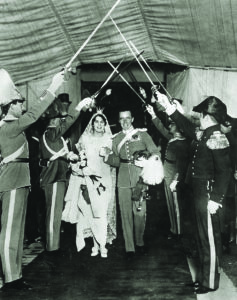
Romaine Manville christened the yacht, built for pleasure and to display status. On the boat deck beneath the bridge and chart room, the forward deck house featured a sunroom from which occupants had an unobstructed view of what lay ahead. Aft of the sunroom were the captain’s stateroom, equipped with a bath and a large wardrobe, and the wireless room. The owner’s suite, also on the boat deck, comprised a beautifully furnished double stateroom with sitting room and bath. Four other double guest staterooms each had private baths. Hi-Esmaro also had two bachelor rooms, plus accommodations for maids and valets. The main deckhouse incorporated a sedate but attractively decorated main salon and dining room paneled in solid teak. Estelle Manville, 24, had married into the Swedish royal family in 1928; replicas of that nation’s crown hung over the stateroom beds. Designed by yacht architect Henry J. Gielow, Hi-Esmaro had two Bessemer diesel engines and a sister ship, Vanda, built simultaneously for a Boston investor. A crew of 50 to 60, sometimes including a surgeon and a barber, staffed each vessel.
For ten years the Manvilles, members of the New York Yacht Club, made abundant use of Hi-Esmaro, often to travel to sailing and crew races up and down the Eastern Seaboard.
One popular entry on the yachting calendar was an annual Harvard-Yale rowing competition along Connecticut’s Thames River. The finish line was a bridge inland from Long Island Sound linking riverside towns Groton and New London, Connecticut. On June 19, 1931, Groton-born canoeist Louis Grimmer, 12, got an eyeful of the Manville yacht. He particularly admired that rakish clipper bow and the mermaid bowsprit.
Louis had been paddling with friends through the spectator fleet anchored at the finish line when guests aboard Hi-Esmaro called down to the boys, “Good morning—who is going to win?”
Harvard did, finishing the four-mile downstream course in 21:29, 13 seconds ahead of Yale. Louis Grimmer never forgot his glimpse of Hi-Esmaro. “I used to dream at night of how I would like to own a yacht, such as this, and travel the world,” he recalled later.
The Manville yacht twice crossed the Atlantic to Europe, where Hiram and Romaine visited with Estelle and her husband, Count Folke Bernadotte. Once, the Swedish royal family joined the Manvilles for a Mediterranean cruise. In spring 1939, when Crown Prince Gustav Adolph and Crown Princess Louise visited New York to open Sweden’s exhibit at the World’s Fair, Manville put the royal couple up aboard the yacht. That September, Germany invaded Poland and the Atlantic became a combat zone.
After growing massively during the Great War, the American military had shrunk, especially the Navy, tightly hemmed by arms-control treaties until resurgent international tension reversed that. In 1938, authorized U.S. Navy tonnage began to rise. By 1940 the Navy had some 2,000 ships and was eager to acquire anything afloat serviceable enough to commission for coastal patrol and similar duties. That October the government bought Hi-Esmaro from Romaine Manville for $150,000; eventually more than half of the 500-odd vessels owned by New York Yacht Club members entered active service. Work began immediately to convert Hi-Esmaro into a warship at the Brooklyn Navy Yard.
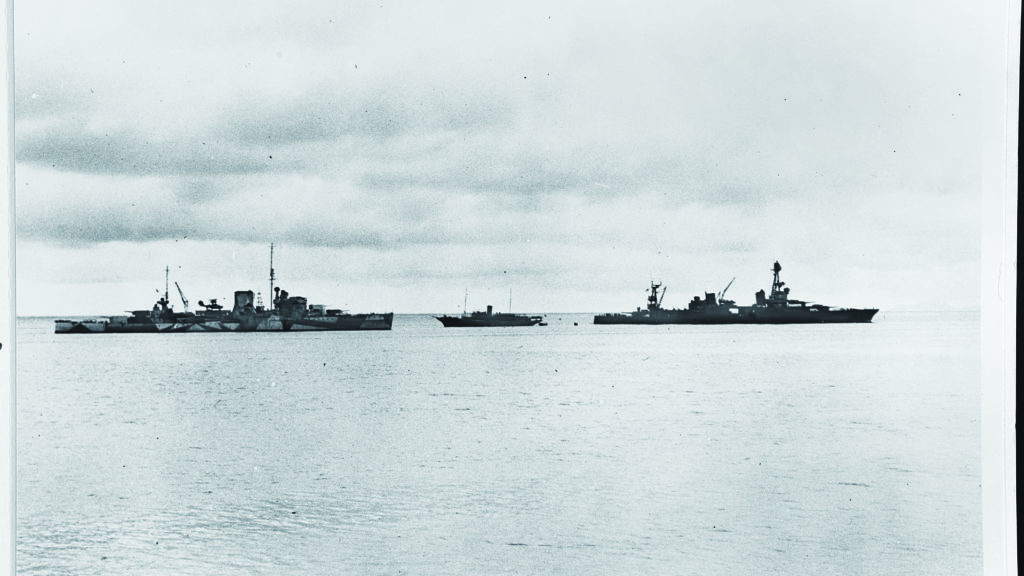
Connecticut canoeing enthusiast Lou Grimmer had joined the Navy. When his destroyer finished a cruise by docking in New York, he got orders to join the crew of a gunboat, USS Niagara (PG-52), as a storekeeper. “I will never forget the thrill I received when I walked down to the dock and found it was the old Hi-Esmaro,” Grimmer said later. It grieved him to watch shipyard workers transmogrifying the yacht for battle, a process that sacrificed not only most of the deluxe interior but also those beautiful lines. Assigned with other sailors to shovel clear the snowbound pier at which Niagara was berthed, Grimmer and mates reached the bow as “the workmen were in the process of removing a bosomly mermaid whom we were all attached to and we pelted them with snowballs, as if we could stop them from their assigned duties.” The yacht-turned-auxiliary-gunboat now was armed with two .50-cal. machine guns as well as two 3-inch guns. The crew totaled 136. The Navy assigned Lou Grimmer elsewhere.
Commissioned at New York in January 1941, Niagara was ordered south. At Miami and Key West, Florida, and at Guantanamo, Cuba, Navy men who were training to go to war in PT boats lived aboard the former yacht. Returning to New York for repairs, Niagara relocated to Newport, Rhode Island, to resume its dormitory role at the Naval Torpedo Station. In August 1941, assigned to the Pacific theater, Niagara departed for Pearl Harbor, Hawaii. Anchoring there October 9, the vessel patrolled the islands until November 29, when Niagara joined a convoy escorting transports and heavy cruiser USS Northampton to Cavite, Philippines, by way of Fiji.
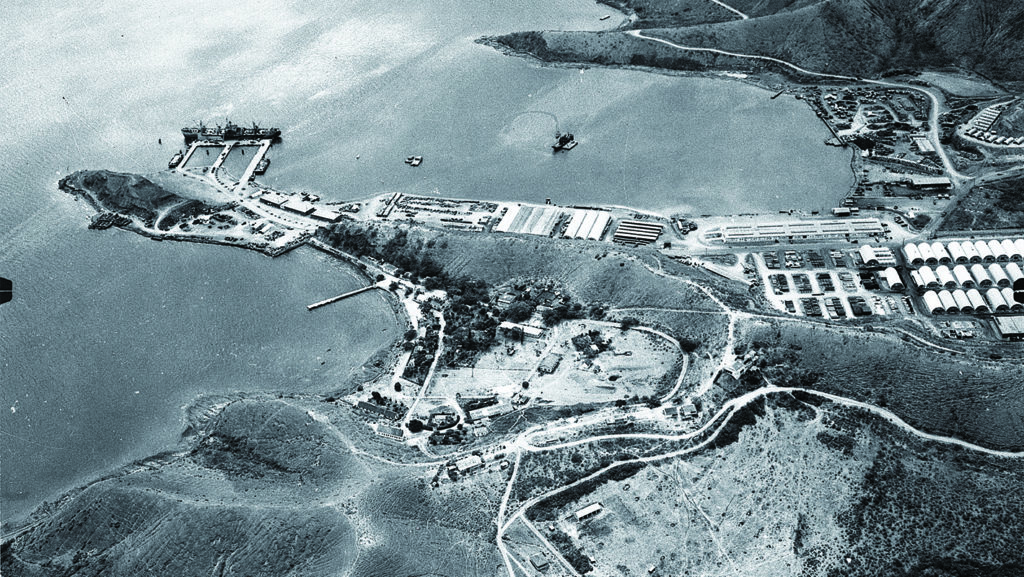
At sea when the Japanese attacked Pearl Harbor, Niagara, unable to keep pace with genuine combat vessels, was ordered to Pearl to assume such supporting duties as convoy escort and service as a tender to PT squadrons. In April 1942 the gunboat sailed east to guard approaches to the Panama Canal.
Overhauled that summer at New York, Niagara returned to Newport as a school ship. However, with the war in the South Pacific gaining scope and intensity, the Navy in that theater, now thick with PT boat squadrons requiring regular refueling, needed tenders—floating resupply vessels stocking fuel and armaments and providing repair services. Shipfitters equipped Niagara with reserve fuel tanks capable of holding 50,000 gallons. In late November 1942, Niagara sailed west via the Panama Canal and the Society Islands, en route officially designated the Navy’s first Motor Torpedo Boat Tender, Auxiliary Gun, Patrol (AGP-1). The crew anchored at Noumea, New Caledonia, on January 17, 1943.
The colonial capital of French New Caledonia, Noumea offered whoever controlled its harbor domination of the Coral Sea and southern Solomon Islands. The sheltered anchorage, now a vital Allied forward naval and air base, was home to an immense armada. The streets of the port were crowded with aviators, sailors, and Marines attached to battleships, aircraft carriers, cruisers, destroyers, repair ships, and smaller vessels.
One transient resident of Noumea was Frederick Ludwig, MD. The Michigan native, a Navy reservist, had left his medical practice in Port Huron to go on active duty. After a hurried two-week indoctrination at Great Lakes Training Center, Dr. Ludwig had sailed by Liberty ship out of San Francisco, debarking at Noumea in November 1942.
He thought it prudent to observe protocol by reporting for duty to his commanding officer clad as the Navy handbook prescribed. Pulling a rumpled, mildewed formal uniform from his seabag, Ludwig, 32, donned his heavy wool dress blues and in tropical heat sweatily quickstepped to headquarters, where a yeoman led him to a darkened room. As Ludwig was entering, a voice boomed, “Come in!” Proffering his orders with a salute to the silhouette in the shadows, the young doctor said, “Lieutenant Fred Ludwig reporting for duty, sir.”
The backlit officer stood.
“My God man, take off those blues!” he barked. “We only wear fatigues out here and never with a tie.”
There was another officer present.
“Are you the Dr. Ludwig just assigned to my hospital?” Captain Fred Conklin asked.
“Yes, sir,” Ludwig answered.
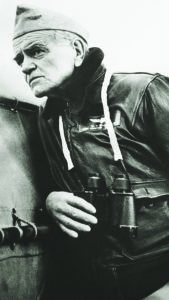
Conklin introduced Fred Ludwig to his host, Vice Admiral William F. “Bull” Halsey, commander of the South Pacific Theater of Operations. “We’re out here to fight a war,” Halsey said, now speaking in a warm voice. “Getting dressed up in coats and ties is a total waste of time.”
From Noumea, Halsey and subordinates were directing the American offensive in the Solomons, sometimes losing badly to Japan’s powerful fleet. Combat in the central Solomons was intense. At the Noumea hospital, Dr. Ludwig saw most of the casualties from those clashes. A case of the mosquito-borne tropical disease malaria made a patient of U.S. Marine Corps fighter ace and future South Dakota Governor Joe Foss. In 1943, Dr. Ludwig was ordered to assume the duties of medical officer aboard AGP-1, bound for the central Solomons. He busied himself stocking surgical instruments and supplies and familiarizing himself with running a commissary. To improve ventilation in the crew quarters, Ludwig oversaw the installation of screened doors, as well as wire mesh over the portholes. The Navy had not obliterated every trace of Hi-Esmaro’s former life. The officers’ mess was paneled in teak, “with linen and silver services that had belonged to Manville,” Ludwig said. “It was the only tender where the master could push a button and the entire bulkhead would fold back and expose an extra bed.” On January 27, 1943, Niagara departed Noumea with Motor Torpedo Boat Division 23, Squadron 8. After stops at Efate and Espiritu Santo, the gunboat took up station at Tulagi on February 17.
Tiny Tulagi, off the larger island of Florida, was chief port and administrative center of the British Solomon Islands Protectorate, and one of the 900-mile chain’s best anchorages. At the start of the war in the Pacific, Tulagi’s coconut planters, traders, missionaries, and government officials had been in the path of Japanese forces sweeping south. A small garrison of Australian infantrymen guarded the civilians and a squadron of amphibious patrol planes and assisted what historian Samuel Eliot Morrison called a “Gilbert and Sullivan army of 15 whites, 5 Chinese and 130 native police in defending their base.”
In May 1942, the Australians evacuated Tulagi; Japanese forces took over. An Allied victory that same month in the Battle of the Coral Sea stopped the Japanese advance.
By the time that Niagara reached Tulagi, the island had been recaptured and repurposed into a PT base. AGP-1 and the PT boats the former yacht supported operated at Tulagi in relative safety, though the small fleet’s anchorage was within range of shore-based aircraft using a major Japanese bastion 650 miles northwest at Rabaul, on New Georgia, and other enemy-held islands north and west.
For concealment, AGP-1’s crew moored north of the Florida Island harbor, tying up to tree trunks against the Maliali River’s high, jungle-rimmed banks. The crew settled into the cycle of tendering: making repairs, restocking torpedo boats with water, fuel, ammunition, and weapons, meanwhile providing communication services for PTs sortieing from Tulagi on nightly security patrols around Guadalcanal.
Only 10° south of the equator, Tulagi was plagued by flies, mosquitos, and a fug of humidity and stale air thickened by daily afternoon rains. Besides doctoring common but vexing tropical maladies—dysentery, ear infections, ringworm, fungus—Lieutenant Ludwig treated combat casualties.
At midmorning on Wednesday, April 7, 1943, coast watchers reported an ominous bustle at Japanese airfields on Bougainville, 380 miles northwest: many planes taking on fuel and bombs. About noon, a message confirmed that a huge Japanese air fleet was bearing down on the Guadalcanal-Tulagi area. Fighter pilots scrambled from Henderson Field on Guadalcanal to intercept more than 170 Japanese attackers. Every ship and shore battery on Florida, Guadalcanal, and Tulagi joined in the defense. Japanese bombs sank oilers USS Kanawah and USS Aaron Ward and Royal New Zealand corvette Moa and did damage to British-built four-masted schooner USS Erskine Phelps, the oldest ship on active sea duty in the U.S. Navy. When nine two-man Aichi “Val” dive bombers swept up the Maliali at tree-top level, machine gunners aboard Niagara and minesweeper USS Rail, moored outboard of the tender, opened fire. The lead Val, damaged and flaming, crashed and exploded in mangroves 1,000 yards aft of Niagara. Two Vals got through, but the fourth was hit. Trailing white smoke, the Val crashed behind hills to the north. The last of the raiders made strafing runs, but in passing through heavy fire from Niagara they too were shot up and crashed in the jungle.
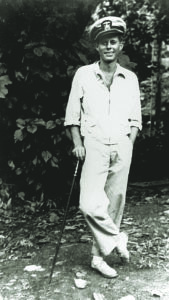
After the attack, Dr. Ludwig treated wounded men, mainly for burns, shrapnel injuries, and stress. Niagara resumed its routine. Repair work continued at a floating drydock. At the Tulagi government wharf, supplies and replacements occasionally arrived. Waiting to take command of a PT boat, newly arrived Lieutenant (jg) John F. Kennedy briefly bunked aboard Niagara.
In May 1943, as Halsey’s South Pacific naval forces were continuing their slow progress north and west, AGP-1’s captain, Lieutenant Commander David B. Coleman, got orders to establish a base on Woodlark Island, 500 miles due west of Tulagi and 150 miles from the immense island of New Guinea. At a British agricultural station on Malaita Island, Ludwig reprovisioned, loading up on fresh tomatoes, lettuce, and beans.
The crew topped off Niagara’s hold and tanks. Early on the morning of Friday, May 22, 1943, Tulagi harbor’s anti-submarine nets opened and AGP-1, laden with 50,000 gallons of aviation fuel plus stocks of torpedoes and depth charges, passed into the sea, escorted by six PTs and bound for Woodlark Island.
By midday, Niagara had swung south of Guadalcanal and was sailing west. Dr. Ludwig was in the galley anticipating a salad from the Malaita gardens to accompany the noon meal.
Crewman Joseph Tropea, topside on watch, noticed a silhouette against the sun: a Mitsubishi 97 heavy bomber.
Tropea alerted the bridge. In a twitch, all hands were racing for their assigned stations to a chorus of “GENERAL QUARTERS…GENERAL QUARTERS…MAN YOUR BATTLE STATIONS.” As the Mitsubishi was closing, Captain Coleman ordered a tight turn to starboard at flank speed. As the 97 was releasing four bombs, Coleman ordered a swing hard to port. Three bombs struck water to starboard, the last near enough to disable the tender’s steering and dislodge the 3-inch gun. “We could not train it, but we could elevate it,” Tropea said. “So we kept firing to keep him from coming down on us.”
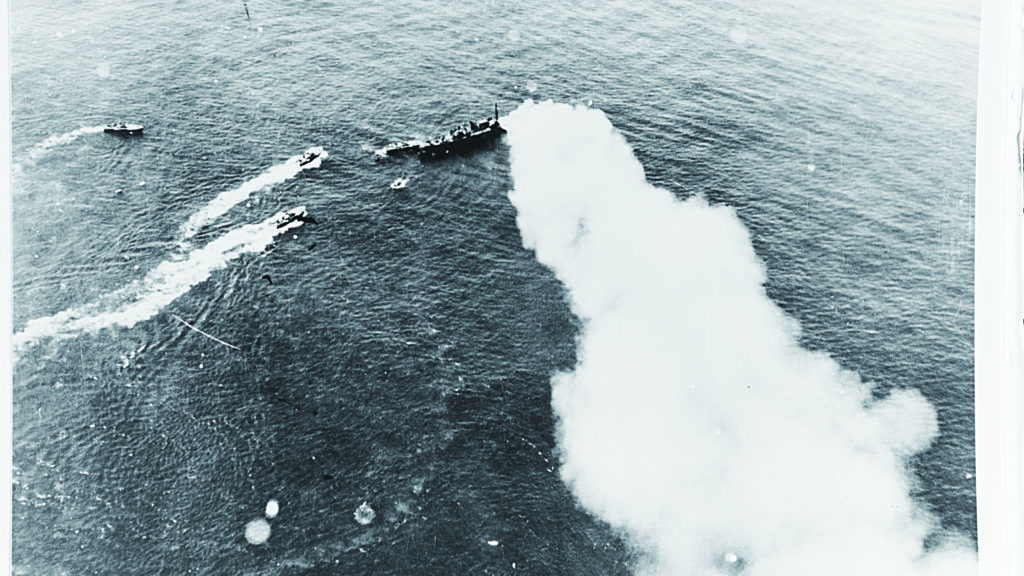
The bomber broke off. The crew got the steering working. In less than an hour the same 97 returned, accompanied by five other warplanes. One bomb in a pattern of more than a dozen hit Niagara’s forecastle. Concussions from near misses caused more damage, including a 14-inch hole six feet below the tender’s waterline. Seawater began flooding two storerooms and a passageway. The power failed. Dead in the water and listing dangerously to port, Niagara had no recourse against attack. Engine room gangs were able to get one of the two main diesels going. Fires were burning below decks forward. Coleman, knowing the result if his stores went up, gave the order to abandon ship.
Tropea was about to leave when he saw flames in an officers’ quarters near an ammunition locker. He and a shipmate brought an extinguisher to bear. When the men ran low on flame retardant, Tropea dashed topside for another extinguisher. A bomb blast knocked him down a gangway, injuring one of his knees. He and the other man kept up their firefighting until an officer ordered them over the side. Most of the crew had already abandoned Niagara for lifeboats or PTs. Tropea, later awarded a Silver Star for valor, wrote, “I had a profound affection for that ship and I would have done anything to prevent it from going down.”
In the engine room, over the sound of bombs and 20mm fire, Seamen Tommy Knight and Cotton Wheeler got an urgent summons. “KNIGHT AND WHEELER, SECURE THE ENGINE ROOM!” the public address system blared. “IF THERE ARE ANY OTHER VOLUNTEERS, LEND KNIGHT AND WHEELER A HAND BEFORE YOU ABANDON SHIP!”
PT-110 commander Lieutenant Patrick Munroe recalled “the Japanese pilots giving us a jubilant wave before they left.” PTs 146 and 147 knifed toward the tender, closing in at either side of the stern to take off men still aboard. The tender was in grievous shape—generators out, pipelines severed, pumps smashed. The foredeck was in flames, bow to bridge.
Captain Coleman ordered a coup de grace by PT-147. The torpedo struck amidships, sending gasoline flames 100 yards high. Black smoke momentarily obscured the vessel, which buckled, bow and stern folding together before sinking beneath a billow of white smoke. Below the surface a lone depth charge detonated with a muffled boom.
Not one of Niagara’s 136 men had been killed or seriously wounded in the action. Rescue vessels landed them at Tulagi early the next morning. U.S. Navy records show that 14 years after being christened as the luxury yacht Hi-Esmaro the USS Niagara received a battle star for World War II service.

